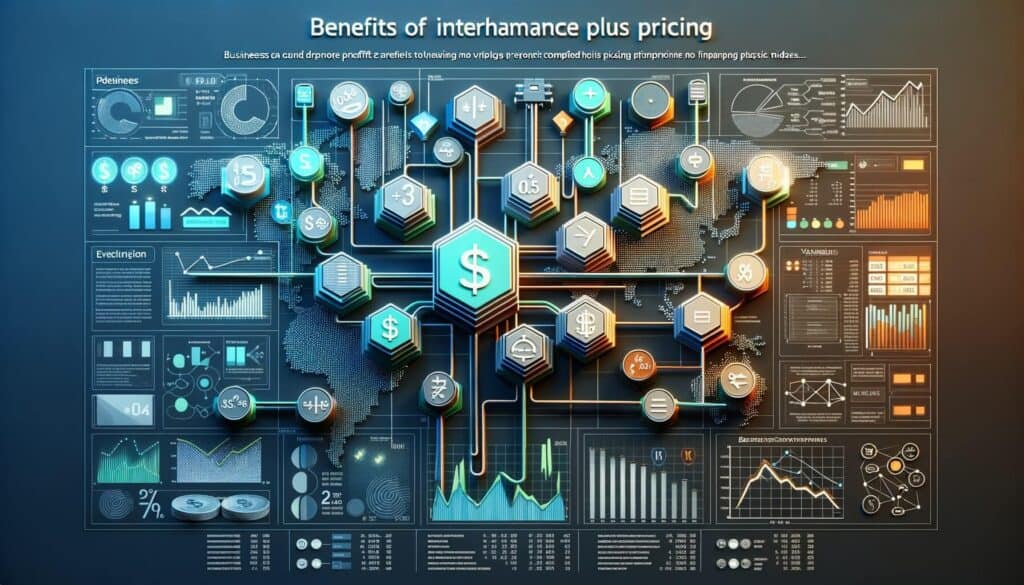
By Harriet Forster January 17, 2025
Interchange Plus Pricing is a payment processing pricing model that has gained popularity among businesses in recent years. It offers transparency and cost savings compared to other pricing models, making it an attractive option for many merchants.
In this article, we will explore the basics of Interchange Plus Pricing, its benefits for businesses, how it works in the payment processing industry, factors affecting pricing rates, comparisons with other pricing models, choosing the right payment processor, common misconceptions, and frequently asked questions.
Understanding the Basics of Interchange Plus Pricing
Interchange Plus Pricing is a pricing model that separates the interchange fees charged by card networks from the markup fees charged by payment processors. Interchange fees are set by the card networks (Visa, Mastercard, etc.) and are non-negotiable. They are based on various factors such as the type of card used, the transaction volume, and the risk associated with the transaction. On the other hand, the markup fees are set by the payment processor and can vary from one processor to another.
The Interchange Plus Pricing model provides transparency by clearly separating these two components of the transaction cost. Merchants pay the actual interchange fee plus a fixed markup fee for each transaction. This allows businesses to see exactly how much they are paying for each transaction and helps them understand the true cost of accepting card payments.
Benefits of Interchange Plus Pricing for Businesses

There are several benefits of Interchange Plus Pricing for businesses. Firstly, it offers transparency, allowing merchants to see the actual interchange fees and markup fees separately. This transparency helps businesses understand their payment processing costs and make informed decisions about their pricing strategies.
Secondly, Interchange Plus Pricing can lead to cost savings for businesses. Since the interchange fees are non-negotiable, the only way for businesses to save on transaction costs is by reducing the markup fees charged by the payment processor. With Interchange Plus Pricing, businesses have the opportunity to negotiate the markup fees and find a payment processor that offers competitive rates.
Furthermore, Interchange Plus Pricing provides flexibility for businesses. Since the interchange fees are based on various factors, such as the type of card used and the transaction volume, businesses can optimize their payment processing costs by understanding these factors and making strategic decisions. For example, businesses can encourage customers to use lower-cost cards or implement measures to reduce the risk associated with transactions.
How Interchange Plus Pricing Works: A Step-by-Step Guide

To understand how Interchange Plus Pricing works, let’s walk through a step-by-step guide:
Step 1: The customer makes a purchase using a credit card at the merchant’s point of sale.
Step 2: The payment processor sends the transaction details to the card network, such as Visa or Mastercard.
Step 3: The card network checks the transaction details and determines the interchange fee based on factors like the type of card used and the risk associated with the transaction.
Step 4: The card network deducts the interchange fee from the transaction amount and sends the remaining amount to the payment processor.
Step 5: The payment processor adds its markup fee to the transaction amount and deducts it from the remaining amount received from the card network.
Step 6: The payment processor transfers the final amount, after deducting the interchange fee and markup fee, to the merchant’s bank account.
Factors Affecting Interchange Plus Pricing Rates

Several factors can affect the interchange plus pricing rates for businesses. The main factors include the type of card used, the transaction volume, and the risk associated with the transaction.
The type of card used can impact the interchange fees. For example, premium cards like rewards cards or corporate cards often have higher interchange fees compared to standard debit or credit cards. Businesses can encourage customers to use lower-cost cards to reduce their payment processing costs.
The transaction volume also plays a role in determining the interchange fees. Higher transaction volumes can lead to lower interchange fees as businesses may qualify for volume-based discounts. On the other hand, lower transaction volumes may result in higher interchange fees.
The risk associated with the transaction is another factor that affects interchange fees. Transactions that are considered high-risk, such as online transactions or transactions with a higher likelihood of chargebacks, may have higher interchange fees. Businesses can implement measures to reduce the risk associated with transactions and potentially lower their interchange fees.
Comparing Interchange Plus Pricing with Other Pricing Models
Interchange Plus Pricing is often compared to other payment processing models, such as tiered pricing and flat-rate pricing. Let’s compare these models to understand the differences:
Tiered Pricing: In tiered pricing, transactions are grouped into different tiers or categories, such as qualified, mid-qualified, and non-qualified. Each tier has a different pricing structure, with qualified transactions having the lowest fees and non-qualified transactions having the highest fees. Tiered pricing can be less transparent as the merchant may not know the exact interchange fee and markup fee for each transaction.
Flat-Rate Pricing: Flat-rate pricing offers a simple fee structure where the merchant pays a fixed percentage of the transaction amount for all transactions. This model can be convenient for small businesses with low transaction volumes. However, it may not be cost-effective for businesses with high transaction volumes as the fees can add up quickly.
Interchange Plus Pricing, in comparison, provides transparency and cost-effectiveness. The merchant can see the exact interchange fee and markup fee for each transaction, allowing them to understand their payment processing costs. Additionally, the fixed markup fee in Interchange Plus Pricing can result in cost savings for businesses with high transaction volumes.
Choosing the Right Payment Processor for Interchange Plus Pricing
When choosing a payment processor for Interchange Plus Pricing, businesses should consider several factors. Firstly, they should compare the markup fees offered by different payment processors. It is important to negotiate and find a payment processor that offers competitive rates to ensure cost savings.
Secondly, businesses should consider the payment processor’s reputation and reliability. It is crucial to choose a payment processor that has a proven track record of providing secure and reliable payment processing services. This will help ensure smooth transactions and minimize the risk of payment processing issues.
Additionally, businesses should consider the payment processor’s customer support and additional features. It is important to choose a payment processor that offers responsive customer support to address any issues or concerns that may arise. Furthermore, businesses should consider any additional features or services offered by the payment processor, such as fraud prevention tools or reporting capabilities, that can enhance their payment processing experience.
Common Misconceptions about Interchange Plus Pricing
There are several common misconceptions about Interchange Plus Pricing that need to be addressed. One misconception is that Interchange Plus Pricing is always more expensive than other pricing models. While it is true that the interchange fees are non-negotiable, businesses have the opportunity to negotiate the markup fees and find competitive rates. With careful consideration and negotiation, businesses can often find cost savings with Interchange Plus Pricing.
Another misconception is that Interchange Plus Pricing is only suitable for large businesses. While it is true that larger businesses may have more negotiating power and may benefit from volume-based discounts, Interchange Plus Pricing can be beneficial for businesses of all sizes. Small businesses can also negotiate competitive rates and benefit from the transparency and flexibility offered by Interchange Plus Pricing.
Frequently Asked Questions about Interchange Plus Pricing
Q: Is Interchange Plus Pricing suitable for all types of businesses?
Yes, Interchange Plus Pricing can be suitable for businesses of all types and sizes. It offers transparency and cost savings, making it an attractive option for many merchants.
Q: Can businesses negotiate the interchange fees?
No, the interchange fees are set by the card networks and are non-negotiable. However, businesses can negotiate the markup fees charged by the payment processor.
Q: How can businesses reduce their payment processing costs with Interchange Plus Pricing?
Businesses can reduce their payment processing costs by negotiating competitive markup fees with the payment processor, encouraging customers to use lower-cost cards, and implementing measures to reduce the risk associated with transactions.
Q: Are there any additional fees associated with Interchange Plus Pricing?
In addition to the interchange fees and markup fees, there may be other fees associated with Interchange Plus Pricing, such as monthly fees or statement fees. Businesses should carefully review the fee structure of the payment processor before making a decision.
Conclusion
Interchange Plus Pricing is a transparent and cost-effective payment processing model that offers several benefits for businesses. It provides transparency by separating the interchange fees charged by card networks from the markup fees charged by payment processors. This transparency allows businesses to understand their payment processing costs and make informed decisions.
Interchange Plus Pricing can be cost-effective for businesses, especially those with high transaction volumes. The fixed markup fee in this pricing model can result in cost savings as transaction volume increases. Additionally, Interchange Plus Pricing offers flexibility, allowing businesses to negotiate the markup fee and choose a fee structure that aligns with their needs.
While there may be some misconceptions about Interchange Plus Pricing, it is suitable for businesses of all sizes and industries. It is not complicated to understand and implement, and many payment processors provide support and resources to help merchants navigate this pricing model.
In conclusion, Interchange Plus Pricing is a valuable option for businesses looking for transparency, cost-effectiveness, and control over their payment processing costs. By understanding the basics, benefits, and workings of this pricing model, businesses can make informed decisions and optimize their payment processing operations.